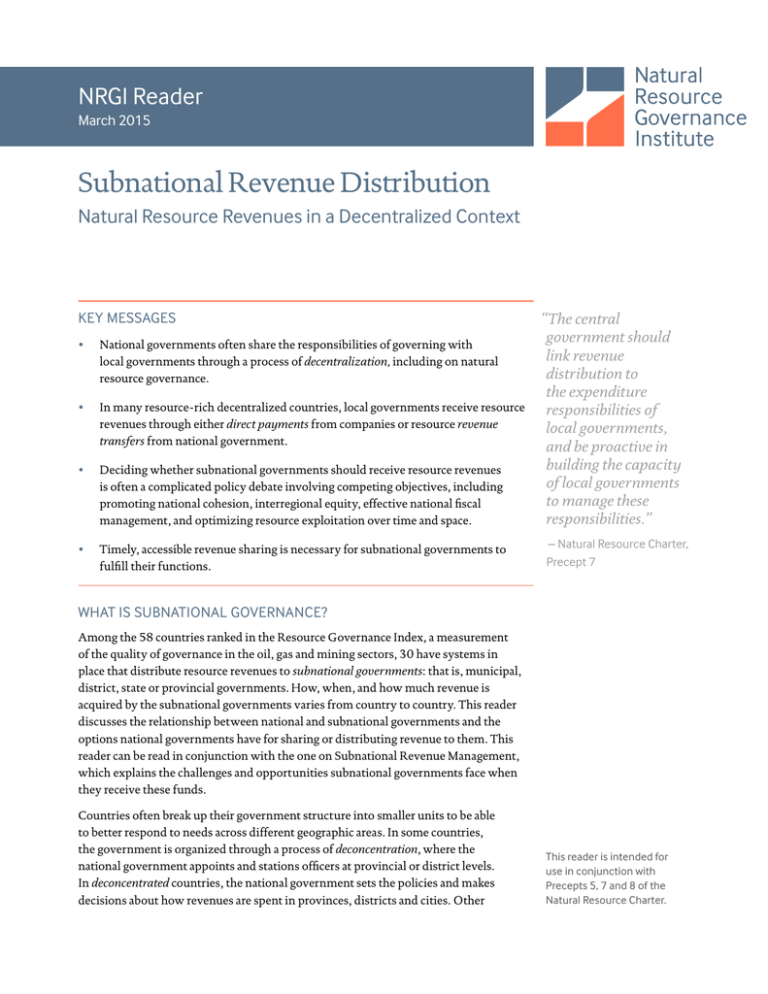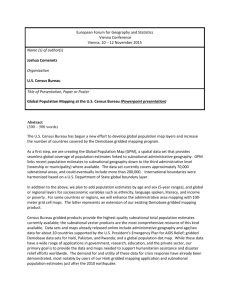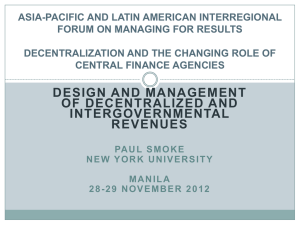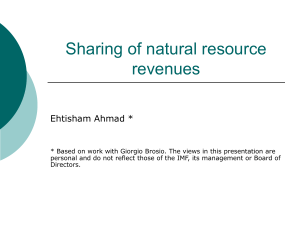Subnational Revenue Distribution NRGI Reader Natural Resource Revenues in a Decentralized Context
advertisement

NRGI Reader March 2015 Subnational Revenue Distribution Natural Resource Revenues in a Decentralized Context KEY MESSAGES • National governments often share the responsibilities of governing with local governments through a process of decentralization, including on natural resource governance. • In many resource-rich decentralized countries, local governments receive resource revenues through either direct payments from companies or resource revenue transfers from national government. • Deciding whether subnational governments should receive resource revenues is often a complicated policy debate involving competing objectives, including promoting national cohesion, interregional equity, effective national fiscal management, and optimizing resource exploitation over time and space. • Timely, accessible revenue sharing is necessary for subnational governments to fulfill their functions. “The central government should link revenue distribution to the expenditure responsibilities of local governments, and be proactive in building the capacity of local governments to manage these responsibilities.” – Natural Resource Charter, Precept 7 WHAT IS SUBNATIONAL GOVERNANCE? Among the 58 countries ranked in the Resource Governance Index, a measurement of the quality of governance in the oil, gas and mining sectors, 30 have systems in place that distribute resource revenues to subnational governments: that is, municipal, district, state or provincial governments. How, when, and how much revenue is acquired by the subnational governments varies from country to country. This reader discusses the relationship between national and subnational governments and the options national governments have for sharing or distributing revenue to them. This reader can be read in conjunction with the one on Subnational Revenue Management, which explains the challenges and opportunities subnational governments face when they receive these funds. Countries often break up their government structure into smaller units to be able to better respond to needs across different geographic areas. In some countries, the government is organized through a process of deconcentration, where the national government appoints and stations officers at provincial or district levels. In deconcentrated countries, the national government sets the policies and makes decisions about how revenues are spent in provinces, districts and cities. Other This reader is intended for use in conjunction with Precepts 5, 7 and 8 of the Natural Resource Charter. Subnational Revenue Distribution countries have decentralized systems where the subnational government body selects its own leaders and has the authority to make policy decisions. While there is a general trend of decentralization throughout the globe, the extent of decentralization varies from country to country. For example, in Zambia the provincial level of government is politically deconcentrated, appointed by the national government, but the district level is partially decentralized. The district governments in Zambia can collect their own taxes, but they must get national approval for all development and spatial plans. In contrast, Indonesia is famous for its rapid decentralization, which gave more than 400 districts the power to collect taxes, save revenues and draft medium-term plans. WHAT EXTRACTIVE REVENUE STREAMS COME TO SUBNATIONAL GOVERNMENTS? In many resource-rich countries that are decentralized, subnational governments receive some revenues from extractive industries. These funds primarily come through either direct payments from companies to subnational governments or transfers from national to subnational governments. Direct payments: A company’s direct payment to a subnational government may be the result of contractual obligation, national law or local regulation. For example, in Argentina, Australia and Canada, provincial governments collect a royalty from mining companies. Subnational governments in Indonesia and Philippines collect fees over mineral licenses they issue. In Peru, until recently, mining companies set up a social fund at the local level that was overseen by subnational governments. Resource revenue transfers: Resource revenue transfers are revenues from extraction companies collected by the national government that are shared with the district, provincial or municipal governments in extraction areas. How much is transferred to which local area varies greatly from country to country. Some countries provide resource-rich areas with a percentage of the revenues that are paid to the national government from extraction in the territory. Other countries use a statutory formula to distribute resource revenues, with a calculation of each area’s share based on several characteristics, such as population size, per capita income or revenue collection effort. In addition to resource revenue transfers, the national government may transfer resource revenues to subnational governments through regular intergovernmental transfers. The amount that is distributed to subnational governments varies from country to country. Some are based on formulas and some on budget proposals. While these are not classified as resource revenue sharing, the funds may be subject to similar challenges of volatility as resource revenue transfers. 2 “In Argentina, Australia and Canada, provincial governments collect a royalty from mining companies.” Subnational Revenue Distribution Case study: Indonesia Indonesia’s “big bang” decentralization of 2001 left subnational governments with unprecedented power to collect and expend revenues, and new responsibility to provide services to their citizens. Those designing the revenue sharing framework wanted to balance national unity with local control. After years of dictatorship, many of the resource-rich regions were among the least developed, and there was concern that the diverse archipelago could quickly disunify. In response, the government established multiple means of sharing resource revenues with the districts and provinces. Two regions, Aceh and West Papua, with large natural-resource wealth and a history of conflict were given 70 percent of all oil revenues in their regions. The remaining resource-rich local governments receive considerably less at 15.5 percent of the government’s profits from oil: 6.1 percent to the producing district, 3.2 percent to all other districts in the producing province, and 3.2 percent to the producing province. While initially resource-rich districts and provinces had few resources to manage the extra funds, today many have employed advance revenue management tools including stabilization and savings funds, transparency mechanisms and development planning. DESIGNING RESOURCE REVENUE SHARING POLICY Political scientists and economists often debate about whether natural resource revenue sharing is the most efficient or effective use of natural resource revenues. Public sector economists, often concerned with the unpredictability of resource revenues and the limited capacity of local governments, tend to recommend central government control over natural resource revenues coupled with intergovernmental transfers based on equalization formulas. Others emphasize the local political, environmental and economic impact of natural resource extraction. They suggest that resource revenues should be shared to address negative local impacts, address concerns of ownership of resources and promote central-district harmony. Some argue that failure to share revenues with subnational governments could increase the possibility for conflict. Figure 1. Indonesia’s petroleum revenue sharing regime Petroleum Revenue District Treasury Central Government Treasury Revenue Sharing for Local Government (15.5% of oil revenue) Central Governments (84.5% of oil revenue) Other Districts in the same Province (3% + 0.2% to education budget) Central Government Budget Province (6% + 0.1% to education budget) “Political scientists and economists often debate about whether natural resource revenue sharing is the most efficient or effective use of natural resource revenues.” Producing District (3% + 0.2% to education budget) 3 Source: Bauer, Andrew, Subnational Oil, Gas and Mineral Revenue Management (NRGI, 2013) Subnational Revenue Distribution Governments respond to these tensions with a variety of policies. Figure 2 provides a snapshot of the variety of revenue sharing schemes among different countries. Whatever revenue sharing scheme a country decides to implement, timely and transparent sharing is necessary for the local government to be able to use the revenues most efficiently. As discussed in the subnational revenue management brief, transparency can also help the subnational government project revenues owed and plan better for medium and long-term development. 100% Figure 2. Extractive industries revenue distribution at the subnational level 80% Source: Matteo Morgandi, Extractive Industries Revenues Distribution at the Sub-National Level (NRGI, 2008) 60% 40% 20% 0% Peru (oil) Nigeria Bolivia Brazil Ghana Indonesia PNG Mexico Landowners by derivation Residual distributed between all munic. Producing regions by derivation Residual distributed between all regions Producing munic. by derivation Central Government Non-prod. munic. in prod. regions 4 QUESTIONS TO ASK: • How does the national government share power with local governments in my country? • Do subnational governments have access to natural resource revenues in my country? If so, how is their share calculated? • Do the resource-rich regions in my country feel like they receive a “fair” share of the benefits from natural resource extraction? Do non-resource-rich regions feel the same? • Is there enough transparency in my country that the subnational governments can understand and predict the potential revenues coming to their area? ADDITIONAL RESOURCES Venugopal, Varsha, and Manley David, Subnational Revenue Sharing (forthcoming in 2015). Bauer, Andrew, Subnational Oil, Gas and Mineral Revenue Management (RWI, 2013), available at: http://www.revenuewatch.org/sites/default/files/RWI_Sub_Oil_Gas_Mgmt_EN_rev1.pdf Morgandi, Matteo, Extractive Industries Revenues Distribution at the Sub-National Level (RWI, 2008), available at: http://www.revenuewatch.org/publications/ extractive-industries-revenues-distribution-subnational-level Pellegrini, Matteo, and Venugopal, Varsha, From Conflict to Collaboration: Lessons learned from RWI interventions in oil, gas, and mineral producing areas (RWI, 2013), available at: http://www.resourcegovernance.org/publications/fact_sheets/conflict-collaboration The Natural Resource Governance Institute, an independent, non-profit organization, helps people to realize the benefits of their countries’ oil, gas and mineral wealth through applied research, and innovative approaches to capacity development, technical advice and advocacy. Learn more at www.resourcegovernance.org




